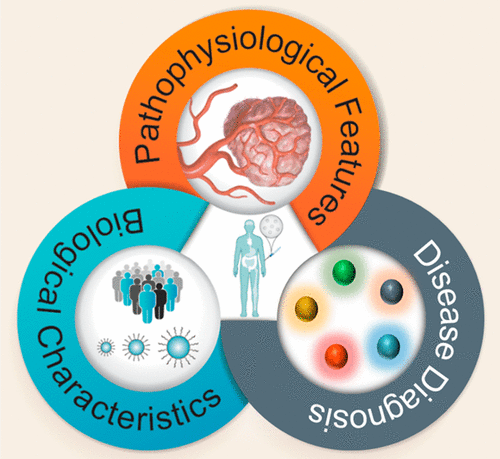当前位置:
X-MOL 学术
›
Acc. Chem. Res.
›
论文详情
Our official English website, www.x-mol.net, welcomes your
feedback! (Note: you will need to create a separate account there.)
Nano–Bio Interactions in Cancer: From Therapeutics Delivery to Early Detection
Accounts of Chemical Research ( IF 16.4 ) Pub Date : 2020-11-12 , DOI: 10.1021/acs.accounts.0c00413 Yuan Liu 1 , Junqing Wang 1 , Qingqing Xiong 1 , Daniel Hornburg 2 , Wei Tao 1 , Omid C Farokhzad 1, 2
Accounts of Chemical Research ( IF 16.4 ) Pub Date : 2020-11-12 , DOI: 10.1021/acs.accounts.0c00413 Yuan Liu 1 , Junqing Wang 1 , Qingqing Xiong 1 , Daniel Hornburg 2 , Wei Tao 1 , Omid C Farokhzad 1, 2
Affiliation

|
Understanding the interactions between nanomaterials and biological systems plays a pivotal role in enhancing the efficacy of nanomedicine and advancing the disease diagnosis. The nanoparticle–protein corona, an active biomolecular layer, is formed around nanoparticles (NPs) upon mixing with biological fluid. The surface layer which consists of rapidly exchanged biomolecules is called the “soft” corona. The inner layer which is more stable and tightly packed is called the “hard” corona. It has been suggested that the NP–protein corona has a decisive effect on the in vivo fate of nanomedicine upon intravenously administration into the mouse. Furthermore, the features of the NP–protein corona make it a powerful platform to enrich low-abundance proteins from serum/plasma for downstream mass-spectrometry (MS)-based proteomics for biomarker discovery and disease diagnosis.
中文翻译:

癌症中的纳米生物相互作用:从治疗提供到早期发现
了解纳米材料与生物系统之间的相互作用在增强纳米药物的效力和促进疾病诊断中起着关键作用。纳米粒子-蛋白质电晕是一种活性生物分子层,与生物流体混合后会在纳米粒子(NP)周围形成。由快速交换的生物分子组成的表面层称为“软”电晕。较稳定且紧密堆积的内层称为“硬”电晕。有人认为,NP-蛋白电晕对体内有决定性作用静脉内给药到小鼠中后纳米药物的命运。此外,NP-蛋白电晕的功能使其成为从血清/血浆中富集低丰度蛋白的强大平台,用于基于下游质谱(MS)的蛋白质组学,用于生物标志物的发现和疾病诊断。
更新日期:2021-01-19
中文翻译:

癌症中的纳米生物相互作用:从治疗提供到早期发现
了解纳米材料与生物系统之间的相互作用在增强纳米药物的效力和促进疾病诊断中起着关键作用。纳米粒子-蛋白质电晕是一种活性生物分子层,与生物流体混合后会在纳米粒子(NP)周围形成。由快速交换的生物分子组成的表面层称为“软”电晕。较稳定且紧密堆积的内层称为“硬”电晕。有人认为,NP-蛋白电晕对体内有决定性作用静脉内给药到小鼠中后纳米药物的命运。此外,NP-蛋白电晕的功能使其成为从血清/血浆中富集低丰度蛋白的强大平台,用于基于下游质谱(MS)的蛋白质组学,用于生物标志物的发现和疾病诊断。











































 京公网安备 11010802027423号
京公网安备 11010802027423号